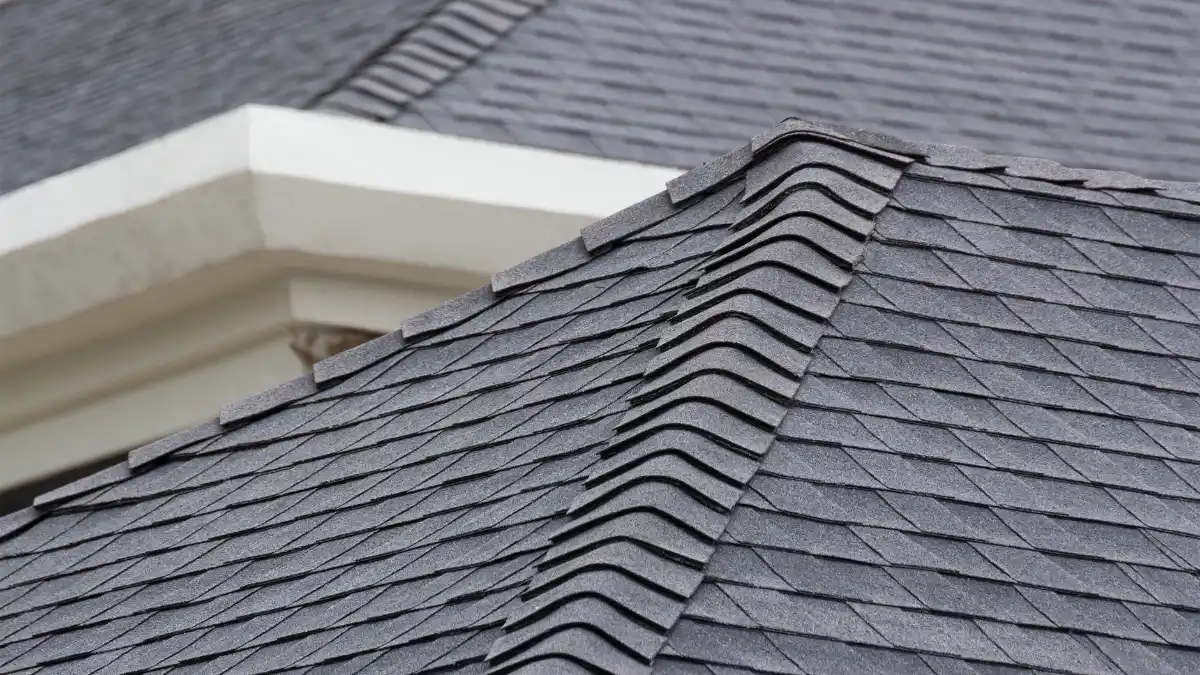The installation of ridge cap shingles is a critical part of roofing projects. Ridge cap shingles cover the top of the roof where two slopes meet, protecting it against weather elements. This prevents leaks and enhances the life of your roof.
Here is an elaborate step-by-step on how to install ridge cap shingles, from selecting materials and preparing the roof to achieve a professional finish.
Materials and Tools Needed
Before you begin, collect all needed items and equipment for an easy installation.
Materials:
- Ridge cap shingles: Buy pre-cut ones or cut them from ordinary three-tab shingles.
- Roofing nails: Use 1 ¼-inch galvanized nails or longer, based on your shingle thickness.
- Roofing felt or underlayment (if needed).
- Roofing sealant or adhesive: (optional for extra safety against strong wind).
- Roofing cement (for finishing and sealing nail heads).
Tools:
- Hammer or nail gun
- Utility knives or heavy-duty scissors are used for cutting the shingles.
- Chalk line (to mark the centre of the roof ridge).
- Measuring tape.
- Ladder or scaffolding.
- Personal protective equipment (roofing harness, gloves and anti-slip shoes).
Free Roof Inspections. Fast. Reliable.
Is your roof ready to weather the storm? Dont risk property damage. Our free roof inspections provide expert analysis to identify potential issues before they become costly problems.
Step-by-Step Guide to Installing Ridge Cap Shingles
Step 1: Prepare the Roof Ridge
The following guidelines can be taken to increase the chances of a successful installation of ridge cap shingles:
- Inspect the roof surface: Ensure that all the coverings on the roof ridge have not been tapped, rotten or have other structural problems. It is also necessary to make some preliminary repairs to the walls if they have been damaged before starting the process.
- Clean the roof ridge: Firstly, clean the area where the installation of the new shingles will take place. A well-cleaned area will ensure proper adhesion of the ridge cap shingles to the roof surface.
- Check the roof’s slope: Ridge cap shingles are usually installed where the slope of the roof is not less than 4:12. For all roofs that are designed flatter, it is advisable to seek a professional for ridge sealing alternatives.
Step 2: Measure and Mark the Centerline of the Ridge
For an effective installation of the shingles, it is important to put the centerline on the roof ridge. For this purpose, you will have to measure accurately and mark the centerline accurately.
- Use a chalk line: Measure and mark a straight line along the ridge where the cap shingles will be installed. This should provide an even placement of shingles on both ends of the ridge.
- Ensure alignment: Verify the measurements and make sure the line is equally aligned with the ridge to avoid any disproportionate spacing of the shingles.
Step 3: Start at the Leeward End of the Roof
Starting from the leeward corner of the roof will help in preventing damage in case of wind blowing during the roofing process. This enables the shingles to overlap correctly, offering protection against wind-borne rains and other harsh weather.
- Lay the first ridge cap shingle: Take the very first ridge cap shingle and place it over the marked centerline, making sure that the top edge of the shingle is aligned with the top edge of the ridge. Edge caps can be homemade, in which case standard three-tab shingles should be cut into separate 12-inch-wide tabs.
- Nail the shingle in place: Make use of two roofing nails, one on each side of the shingle, about six inches from the ridge edge and one inch from the shingle edge, and nail the shingle into position. In order to properly hold the shingle in place, the nails must go into the roof deck by at least ¾ of an inch.
- Overlap the next shingle: Place the next ridge cap shingle so that it overlaps the previous one by 5 to 6 inches, thus concealing the nails. Continue in this manner until you reach the end of the ridge opposite the starting point.
Step 4: Continue Installing Ridge Cap Shingles
Once the first shingle is in place, proceed to install the rest of the ridge cap shingles along the ridge, with each shingle lapping over the previous one by around 5 to 6 inches. Use the following suggestions carefully to ensure a proper installation:
- Observe a uniform lap: For aesthetic continuity, it is important to keep uniformity in the lap on each shingle. This ensures that the ridgelines stay straight and that maximum weather protection is provided.
- Keep the nails uniform: See to it that the nails placed on every shingle are spaced uniformly and at a similar distance from the ridge. Doing so will ensure that the shingles lay flat and firmly in place.
- Make the appropriate cuts: When it comes to the edge of the ridge, the last shingle might require some adjustments to its shape. Make use of a sharp utility blade to cut the last shingle down to the required size while ensuring the last one overlaps the previous one.
Step 5: Seal the Ridge Cap Shingles
To ensure even further safety, especially in locations exposed to strong winds or any extreme weather, roofing adhesive or cement could be used to seal the ridge cap shingles.
- Apply roofing adhesive: If you decide to go with adhesive, keep in mind that after nailing a ridge cap shingle in place, a thin layer of the adhesive should be spread to the underside of the shingle. This will make sure that the shingles do not get blown away during windy conditions.
- Seal exposed nails: After all the shingles have been put in place, apply roofing cement on the exposed nail heads. This is crucial for preventing water penetration, especially in regions with plenty of rain or snow.
Step 6: Install a Ridge Vent (Optional)
Ridge Ventilation is an additional feature that can be incorporated into your house besides the required ones. On the other hand, if the roof is to be vented, then the installation of a ridge cap should be done after the ridge vent has been fixed. With the use of a ridge vent, air can flow in and out of the attic space, which enhances the efficiency of the house and increases the life expectancy of the roof.
- Create an opening for the vent: Measure and draw the outline where the ridge vent will be fitted, then use a circular saw cut along the ridge pavement to form a cut. The width of the opening should be between 1 – 2 inches wide, depending on how large the vent is.
- Install the ridge vent: Place the ridge vent above the open slot and nail it down using roofing nails. Be sure to follow the manufacturer’s instructions regarding the proper installation of the product.
- Fix ridge cap shingles over the vent: Fix the ridge cap shingles as earlier described after fixing the vent, ensuring they cover the vent for a uniform appearance.
Step 7: Inspect the Finished Installation
To encourage proper bonding between the ridge cap shingles and the roof, spend some time reviewing the process and ensuring everything is properly fixed.
- Check for loose shingles: Stroll across the roof and gently pull each ridge cap shingle to make sure it is not loose. Any shingles that seem to be loose will need additional nails or adhesive to secure them.
- Examine the orientation of the nails: Ensure that every nail has been inserted straight and all shingles are fastened tightly in place. If any of the nails appear bent, bulging, or protruding outwards, take them out and put in new ones.
- Look for gaps or misalignment: Check for missing shingles, improper alignment of the shingles or improper overlaps on the ridge line area. Make corrections, if needed, before completing the job.
Step 8: Clean Up the Work Area
Upon completion of the installation process, tidy your work area by removing any installation material and any other debris.
- Pick up any loose nails or scraps: Don’t forget to gather all nails that may have fallen on the roof or that were stuck on the shingles, shingle leftovers, etc. A magnetic sweeper is somewhat advantageous in the aspect of being used to pick up floating nails.
- Dispose of waste properly: Old shingles, packing materials and other waste matter have to be discarded according to environmental regulations in the area. It has become common to find certain regions that have set acceptable ways of disposing of roofing materials; hence, it is advisable to check on this.
Common Mistakes to Avoid
To ensure a successful ridge cap shingle installation, be aware of the following common mistakes and how to avoid them:
- Using the wrong type of shingle: It is always recommended to install ridge cap shingles that are suitable for your roof’s pitch and climatic conditions. Steep roofs and areas with strong winds require stronger protection, which may not be provided by standard shingles.
- Not using enough nails: Remember to use the suggested quantity of nails for every shingle. Excessive fastening will lead to the formation of gaps on the roof, and the usage of fewer nails in shingles makes them susceptible to being blown away by strong winds.
- Improper overlap: Ensure that each ridge cap shingle overlaps the previous one by about 5 to 6 inches. Insufficient overlap also makes the roof prone to water leaks, while excessive overlaps make the ridge line appear uneven and bulky.
- Skipping the adhesive: While fixing ridge cap shingles, use roofing adhesive in addition to nails. This reduces the chances of the ridge cap shingles being blown off, especially in areas that are frequently encountered by forceful winds. Failure to follow this step may result in a situation where the shingles are blown off during a storm.
Conclusion
Installation of ridge cap shingles forms part of the roofing procedure that can only be undertaken with a lot of precaution. With the help of these guidelines, you can ensure your roof is strong and resistant to extreme weather, complementing it with the aesthetic exterior and durability of your roof. It is recommended that you do not rush through the process of installing ridge cap shingles and that you optimize the use of quality materials when constructing your roof – and, of course, it is always important that you attach paramount concerns to safety at the workplace. With preparation, the right tools, and the right technique, you will be able to achieve the perfect look for your roof that will last for years.
Ready to Secure Your Roof? – Contact River City Roofing
If you need good quality ridge cap shingles, River City Roofing is your go-to company for professional roofing installation. Whether you are getting a brand new roof, need some roof repairs, or even need to check your ridge cement capping, our team is here for you!
Why should you hire River City Roofing?
Our professional roofers have the knowledge when it comes to ridge cap shingles, and they have experience when it comes to the installation of roofs. We employ high-standard quality material for roofing to protect against water seepage, wind, and storms. We always work with warranties for all kinds of projects, which provide you with a warranty for the product for years.
You can contact us right now and get a free, no-obligation quote for your roofing work.



